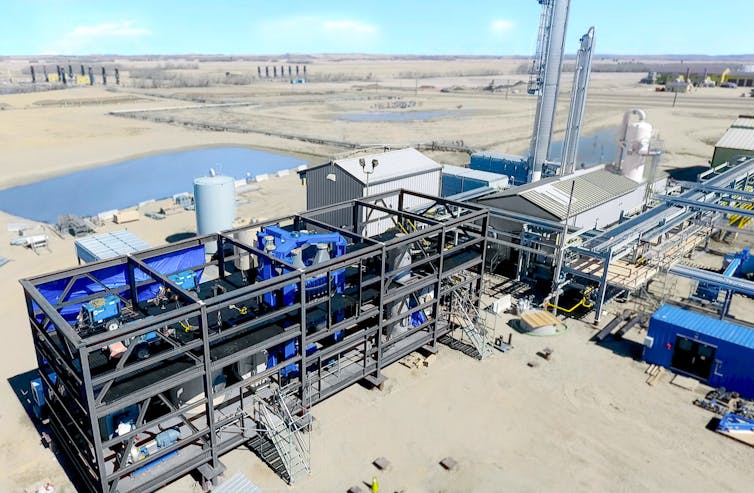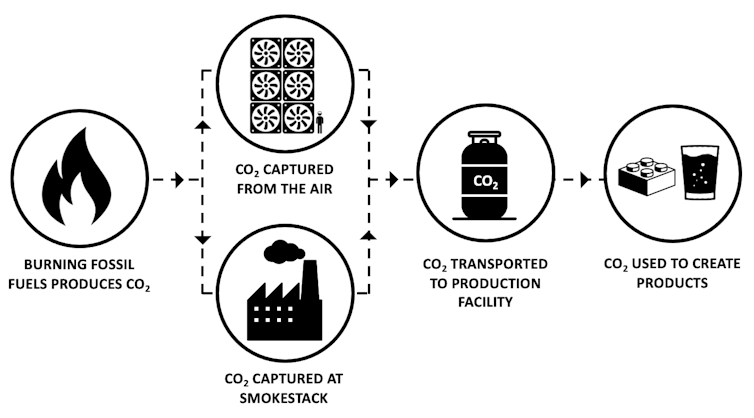
Experts in autocracies have pointed out that it is, unfortunately, easy to slip into normalizing the tyrant, hence it is important to hang on to outrage. These incidents which seem to call for the efforts of the Greek Furies (Erinyes) to come and deal with them will, I hope, help with that. As a reminder, though no one really knows how many there were supposed to be, the three names we have are Alecto, Megaera, and Tisiphone. These roughly translate as “unceasing,” “grudging,” and “vengeful destruction.”
As the climate continues to change without regard to stupid humans who continue to do things which will accelerate that change ans, if we don’t stop, ensure out own extenction, those of us who can see what it going on have to be more determined, and smarter, at coming up with ways to stop and, if possible, even reverse the damage already done. As ideas go, this one seems to hold promise.
================================================================
Using captured CO₂ in everyday products could help fight climate change, but will consumers want them?

FotographiaBasica via Getty Images
Lucca Henrion, University of Michigan; Joe Árvai, USC Dornsife College of Letters, Arts and Sciences; Lauren Lutzke, USC Dornsife College of Letters, Arts and Sciences, and Volker Sick, University of Michigan
Would you drink carbonated beverages made with carbon dioxide captured from the smokestack of a factory or power plant?
How would you feel if that captured carbon dioxide were in your child’s toys, or in the concrete under your house?
The technology to capture climate-warming carbon dioxide emissions from smokestacks, and even from the air around us, already exists; so too does the technology to use this carbon dioxide to make products like plastics, concrete, carbonated drinks and even fuel for aircraft and automobiles.
That combination – known as carbon capture and utilization – could take up billions of tons of carbon dioxide emissions if the technologies were adopted across a range of sectors worldwide.
But for that to happen, the public will have to accept these new products. Will they? That’s a question we have been exploring as engineers who work on carbon capture technologies and as social psychologists.
One key to success: CCU adds economic value
Studies show that to stabilize the climate by 2050, the world will have to do more than just stop greenhouse emissions. It also will have to remove huge amounts of carbon dioxide from the atmosphere. Trees, soils and oceans naturally store some carbon dioxide, but human activities produce about five times more than nature can handle.
That’s why technologies that can reuse carbon dioxide to avoid fossil fuel use – or even better, lock it away in long-lived products like cement – are essential.
The key to carbon capture and utilitization’s potential is that these products have economic value. That value can give companies the incentive to deploy the technology at the global scale necessary to slow climate change.

Svante
Carbon capture technology itself isn’t new. Initially, captured carbon dioxide was used to force oil and gas out of old wells. Once emissions are captured, typically from an industrial smokestack via a complex chemical filter, they can be pumped deep underground and stored in depleted oil reservoirs or porous rock formations. That keeps the carbon dioxide from reaching the atmosphere, where it can contribute to climate change.
But storing carbon dioxide in the ground doesn’t create a new product. The absence of an economic return – coupled with concerns about storing carbon dioxide underground have slowed the adoption of the technology in most countries.
How do people feel about carbon dioxide-based products?
For many products made with captured carbon dioxide, success will depend on whether the public accepts them.
Two of us recently conducted one of the first large-scale studies to examine public perception of carbon dioxide-based products in the U.S. to find out. We asked over 2,000 survey participants if they would be willing to consume or use various carbon dioxide-based products, including carbonated beverages, plastic food storage containers, furniture made with foam or plastic, and shatterproof glass.
We found that most people knew little about carbon capture and use. However, 69% were open to the idea after learning how it worked and how it helped reduce the emissions contributing to climate change.

Lauren Lutzke/University of Southern California
There was one exception when we asked about different types of products people might be willing to use: Fewer people – only 56% – were open to the idea of using captured carbon dioxide in carbonated beverages.
Safety was a concern for many people in the survey. One-third didn’t know if these products might pose a health risk, and others thought they would. It’s important to understand that products made with captured carbon dioxide are subject to the same safety regulations as traditional materials used in food and consumer products. This includes filtering out unwanted pollutants in the flue gas before using the carbon dioxide in carbonated beverages or plastics.
When carbon dioxide is used as a raw material, it becomes chemically stable once it is used to create a product, meaning carbon dixoide used to create plastic will not turn back into a gas on its own.
What people may not realize is that the majority of carbon dioxide currently used nationwide is already a fossil fuel byproduct from the steam-methane reforming process. This carbon dioxide is used widely for purposes that include making dry ice, performing certain medical procedures and carbonating your favorite soda.
Overall, we found that people were open to using these products, and that trend crossed all ages, levels of education and political ideologies.
Carbon capture and use already has bipartisan support in Washington, and the Department of Energy is funding research in carbon management. Bipartisan consumer support could quickly expand its use, creating another way to keep carbon emissions out of the air.
Over 77 million tons of carbon dioxide was captured worldwide in 2020, but use of that carbon dioxide lags behind. One use that is quickly expanding is using carbon dioxide to cure, or harden, concrete. A company called CarbonCure, for example, has permanently stored over 90,000 tons of captured carbon dioxide in concrete to date.
Recently, Unilever and partners piloted replacing fossil-based ethanol with carbon dioxide-based ethanol for manufacturing laundry detergent, significantly reducing the associated ethanol emissions. Both are cost-competitive methods to capture and use carbon dioxide, and they demonstrate why carbon capture and use could be the most market-friendly way to remove carbon dioxide on a large scale.
How innovators can improve public perception
Some emerging technologies could help address the perceived risks of ingesting carbon captured from industrial emissions.
For example, a Coca-Cola subsidiary is piloting a project in which carbon dioxide is captured directly from ambient air using direct air carbon capture technology and then used in drinks. Although it’s currently expensive, the costs of direct air carbon capture are expected to fall as it is used more widely, and its use could reduce people’s concerns about health risks.
The most important steps may be educating the public about the process and the value of carbon dioxide-based products. Companies can alleviate concerns by being open about how they use carbon dioxide, why their products are safe and the benefits they hold for the climate.![]()
Lucca Henrion, Research Fellow at the Global CO2 Initiative, University of Michigan; Joe Árvai, Dana and David Dornsife Professor of Psychology and Director of the Wrigley Institute for Environmental Studies, USC Dornsife College of Letters, Arts and Sciences; Lauren Lutzke, PhD student, USC Dornsife College of Letters, Arts and Sciences, and Volker Sick, Arthur F. Thurnau Professor; DTE Energy Professor of Advanced Energy Research; and Director, Global CO2 Initiative, University of Michigan
This article is republished from The Conversation under a Creative Commons license. Read the original article.
================================================================
Alecto, Megaera, and Tisiphone, frankly, capturing CO₂ sounds pretty good to me, and I particularly like the ability to actually make it useful in things like multiple-use plastics. I love glass, but I’m such a klutz that most of the time I’m afraid to use it (my inner cat likes to knock things off of surfaces whether I want to or not.) Actually, shatter-proof glass sounds good too (but they’ll mostly want that for windshields, and windows onfloors above ground level. I expect.) I wold even be willing to try it in carbonated beverages. But one person does not a market make. We’ll have to see how it works in real life.Anyone know any entrepreneurs who might be interested?
The Furies and I will be back.
4 Responses to “Everyday Erinyes #268”
Sorry, the comment form is closed at this time.

Thanks Joanne. I’ve seen example stories before, yet none like this that quantify any effort/product.
The first thing I thought about as I began reading was wondering if sufficient of this kind of cement could reach Gaza for rebuilding to at least off-set the added greenhouse gases from Israel’s planes, tanks, troop movement, bombs, etc….
Yes, I would buy/use products made of captured carbon…..it should be an easy answer….
Well, I can understand people being a bit nervous about drinking it – but otherwise, I agree, it ahould be easy.
I buy toilet paper made from recycled paper (no, not recycled toilet paper), I have glassware made out of recycled glass, I have buckets made out of recycled plastic, I have shoes with soles made out of recycled material…I could go on and on. So why not buy items made with captured CO₂? Can’t think of any reason at all.